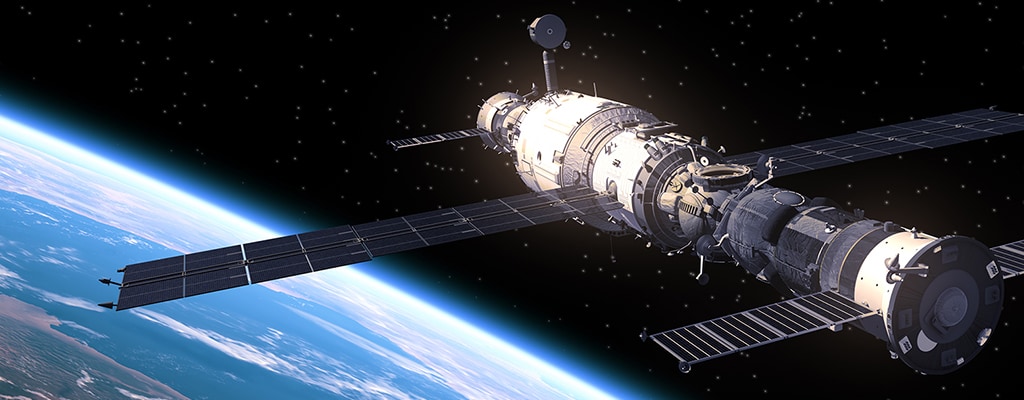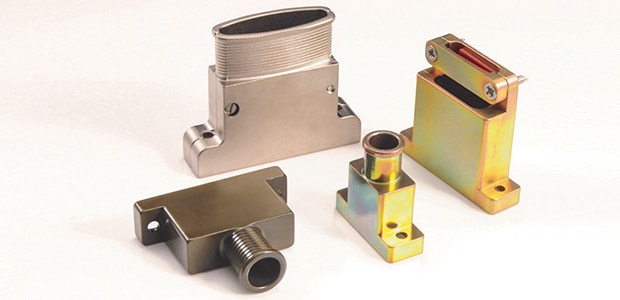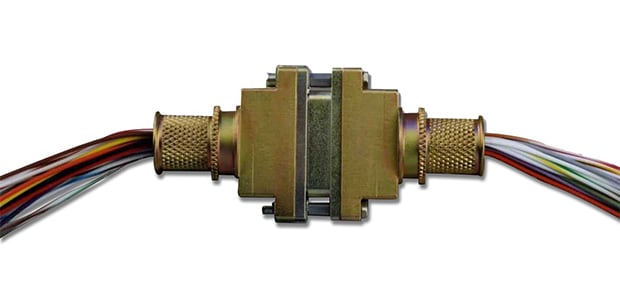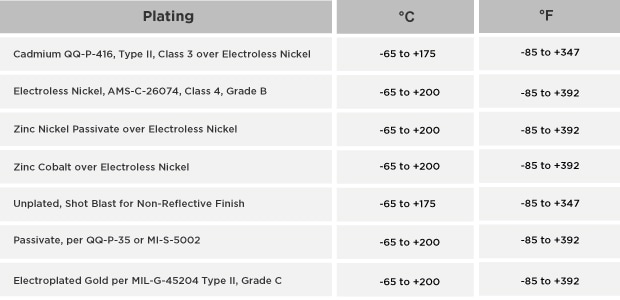
Trend Insight
Space-Grade Backshells for Micro-D and D-Sub Connectors
When choosing backshells for space applications, strain relief and EMI / RFI shielding are some of the performance features needed to withstand harsh conditions.
Finding the Right Backshells
As designers evaluate the capability of a backshell to protect connector-to-wire and -cable terminations, it pays to consider high-quality, economical solutions that can handle multiple challenges. Key functions provided by backshells include strain relief at the back portion of the shell (where contacts connect to wires or cable), electromagnetic interference (EMI) shielding, and environmental protection.
Material properties of aluminum-alloy or composite thermoplastic backshells must exhibit rugged, lightweight and precise-mating features. Physical performance must include the ability to withstand shock, vibration, temperature and corrosion. Handling these challenges is especially critical when electronic systems are subjected to supersonic speeds and high gravitational (g) forces.
TE Connectivity (TE) Micro-D and D-Subminiature backshells for spacecraft applications meet the functional, material and performance demands — where quality and affordability count.

Meeting Key Functional Challenges of Using D-Sub and Micro-D Connector Backshells
The evolution of D-shaped connectors has gone from D-Subminiature (D-Sub) connectors developed in the 1950s to more compact Microminiature D (Micro-D) designs introduced in the early 1970s to today’s high-performance D-Sub and Micro-D versions that take advantage of advanced rectangular backshell technology for space-grade applications.
Today, rack and panel connectors can utilize highly specialized TE D-Sub backshells for MIL-DTL-24308-compliant mating and Micro-D backshells for MIL-DTL-83513-compliant mating in compact, rectangular form factors. As with standard circular designs, rectangular backshells deliver key functional advantages, which include:
Incorporating Strain Relief
Strain relief supports cable and wire to help prevent overbending or flexing. This can be achieved with a heat-shrink boot, cable clamp or tie post, depending on customer preferences and testing requirements. Cable clamps help prevent wires from pulling on contacts and general mechanical damage to the termination. Saddle bar cable clamps are integrated into the backshell to simplify installation. However, strain-relief backshells do not provide any EMI or environmental protection and should be used only in clean, dry environments.
Preventing Electromagnetic Interference (EMI)
EMI — also known as radio frequency interference (RFI) when in the radio frequency spectrum — can affect an electrical circuit by electromagnetic induction, electrostatic coupling or conduction. To help avoid the effects of EMI, electromagnetic compatibility (EMC) shielding can employ a properly grounded braided shield or screen terminated to the backshell. To secure the shield/screen, a Standard Band or Micro-Band can be used.
Additional methods of preserving the integrity of parts include:
Guarding Against External Contaminants
To protect backshells from the environment, the whole assembly must be sealed with a heat-shrink boot. The boot itself must be properly sealed with a potting compound or an adhesive to help prevent water or other fluids from entering wiring. Another solution is to provide a protective cover at the rear of a connector that is used as a stand-alone device.
Grounding the System
Terminating a shield at the backshell will ground the system. The most basic cable shield termination comprises connecting the full circumference of the cable shield to the backshell. It must then be connected to the enclosure and ultimately connected to the airframe to help ensure a closed system without a ground loop. Using a backshell for grounding is particularly valuable in situations where grounding is not allowed through a pin.
Meeting Material Challenges of Space-Grade Backshells
Backshells in space-rated applications require specialized materials processing and precise mating interfaces. For metallic backshells, the base material and plating must be matched to prevent galvanic corrosion between dissimilar metals. For composite thermoplastic backshells, the nonmetallic material does not corrode, weighs less than metal and can better withstand harsh environments.
Backshells in either material are available in solder cup, pre-wired and printed circuit board (PCB) versions.
- Aluminum backshells are made from lightweight, rugged, machined aluminum alloy and employ stainless-steel accessory hardware. Plating is typically done with electroless nickel, which provides a low-resistance, conductive finish appropriate for nonenvironmental applications. Gold plating offers excellent resistance to space corrosion and radiation. Because cadmium plating sublimates in a vacuum, it is not acceptable in applications where outgassing is a concern.
- Composite thermoplastic backshells are made from chemical-resistant composite thermoplastic materials that significantly reduce interconnect system weight and handle SO2 fog better than metallic. Because composite housings are transparent to EMI, electroless nickel plating is used for EMI shielding.
Precision mating helps ensure the electrical integrity of an interconnect by eliminating discontinuity in diameters between pairs. Precision-machined backshells enable not only accurate mating between interfaces, but also strong mating retention force. For easy installation over terminated wires, split-shell backshells can fit over the connector without a ferromagnetic clip component and employ screw locks to couple connectors. (One-piece backshells, in contrast, must be placed on the wire bundle before wire-to-connector terminations are completed.) Backshells requiring a platform for banding straps can utilize a low-profile Micro-Band that accommodates narrow, space-saving band widths.

Meeting Performance Challenges of Space-Grade Backshells
During launch, flight and orbit, backshells used in interconnects aboard spacecraft are subjected to extreme conditions requiring critical performance features.
Shock and Vibration Protection
Specific backshell features play a critical role in maintaining electrical continuity by reducing stress and strain during violent shaking and extreme g-forces. TE D-Sub and Micro-D backshell features are designed to meet customer requirements suitable to the application, not generic specifications.
* Tip for Success: When EMI shielding is required, the designer can use Micro-Band termination for that purpose, plus enjoy a measure of protection against inadvertent removal due to vibration and shock. A self-coupling locking nut on the band improves mechanical protection against loosening under vibration.
Incorporating tie posts into banded backshells can achieve light-duty strain relief. Tie posts are optional in banded Micro-D backshells because wires are typically potted in place and the shield braid adds sufficient strain relief. Potting alone provides some strain relief as the epoxy resin or other material used to fill the space in the rear of a connector will harden into a solid, offering a degree of holding force to support the contacts in the housing.
Cable entry points are also vulnerable to vibration. Elliptical-shaped cable entries can be employed to reduce contact angles to minimize areas of wear compared to round cable entries. However, uneven force around bands in elliptical-shaped cable entries causes problems as the larger radius tends to allow braiding to pull out. Proper processing can mitigate this problem, but this type of entry is not recommended in high-vibration conditions.
Temperature Tolerance
Whether at very high peak temperatures, low troughs, or cycling between high and low temperatures, extreme heat and cold stress materials — metal, glass and polymers — and can cause cracking and fatigue. They can also distort assemblies and rupture seals due to different coefficients of thermal expansion.
Generally, TE backshells are certified to the MIL-STD-883 temperature cycling test range of -55°C to +125°C. However, specialized materials and platings are available to handle the cryogenic cold of space and for higher-temperature electronics (Figure 1).

Outgassing Control
Outgassing occurs when gases trapped in non-metallic materials — such as polymers used in connector inserts, seals, adhesives or potting materials — are released in the vacuum of space or by high temperatures. The released gases can condense on and contaminate sensitive surfaces, eventually degrading the performance of charge-coupled-device (CCD) sensors in satellites, thermal radiators or solar cells.
NASA ASTM E595-77/84/90 testing and the MIL-W-22759 (M22759) | SAE AS22759 specification cover a material’s performance when exposed to high heat or a vacuum. Materials considered low-outgassing materials meet requirements for a Total Mass Loss of 1.00% or less and a Collected Volatile Condensable Material (CVCM) of 0.10% or less.
* Tip for Success: Space-grade Micro-D connectors and backshells must meet MIL-DTL-83513 requirements for material outgassing in a vacuum environment.
Ultraviolet Resistance
In space, there is no atmosphere to protect materials from the effects of X-ray, gamma and cosmic radiation. Ultraviolet (UV) degradation adversely influences material properties of electronic components — and can even change the molecular composition of materials. It does this by removing oxygen atoms from oxygen-containing substances. As a result, thermal control subsystems may not function properly, optics can be degraded and solar arrays can become less efficient.
At low-Earth-orbit (LEO) altitudes between 200 km and 700 km, UV excitation of the remaining O2 molecules at the fringe of the atmosphere forms monatomic oxygen. Atomic oxygen (ATOX) corrosion occurs when these highly reactive monatomic oxygen molecules erode aluminum and plastics. One solution is to employ materials with low galvanic potential, such as space-gradepolymers, thermoplastic composites and glass (fiber optics).
Plating and coatings can be used with alloys to avoid forming an electrolytic cell. Gold plating resists ATOX corrosion because gold is a noble metal that normally resists oxidation. Silicon dioxide coatings can protect polymers from ATOX corrosion because SiO2 is already fully oxidized. More generally, LEO satellites can utilize special UV shielding for their electronics systems to minimize UV degradation and protect components.
More Capabilities for Space-Grade Interconnections
Today, the challenges for interconnects in space applications are expanding, as the size and weight of components and packages must decrease. TE offers a wide range of NASA- and MIL-SPEC- compliant products — along with connectors, cables and full harnessing capabilities — to help meet most data, video, optical and control-communications needs in aerospace.
Space-grade backshells from TE are designed to withstand the most rigorous conditions while maintaining precision mating. No matter the challenge, count on our technical expertise, design engineering and manufacturing capabilities to support your mission — from launch to intercept or deployment.
Key Takeaways
- Selecting the right backshell for space applications is vital to the success of any mission.
- Key functional challenges include strain relief, electromagnetic interference (EMI), sealing out environmental irritants and ensuring that the system is properly grounded.
- The materials used in backshells for space-rated applications must be resistant to corrosion and able to withstand harsh environments.
- Some of the extreme conditions that pose performance challenges include shock and vibration, extreme temperatures and temperature change, outgassing, and exposure to harsh rays outside the Earth’s atmosphere.
- Looking to the future of interconnects for space applications, parts must be optimized for size and weight.

